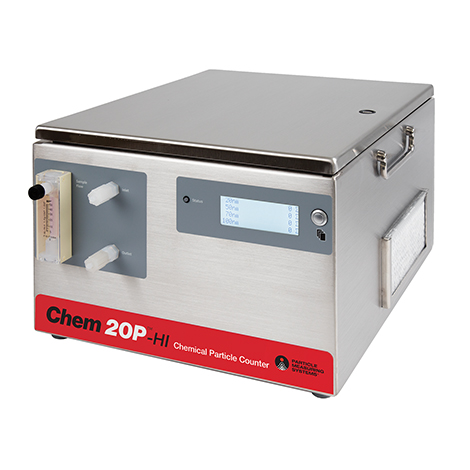 The critical particle size for today’s leading-edge semiconductor technology is shrinking. Now in the sub-10 nm size-range, the control and mitigation of potentially yield-impacting particles is growing more important. Here, we’ll discuss how the Chem 20™ Chemical Particle Counter’s industry-leading sensitivity can be applied throughout the microelectronics industry in for Controlling Contamination in High-Purity Chemicals:
The critical particle size for today’s leading-edge semiconductor technology is shrinking. Now in the sub-10 nm size-range, the control and mitigation of potentially yield-impacting particles is growing more important. Here, we’ll discuss how the Chem 20™ Chemical Particle Counter’s industry-leading sensitivity can be applied throughout the microelectronics industry in for Controlling Contamination in High-Purity Chemicals:
- Chemical suppliers
- Incoming chemical deliveries
- Chemical distribution modules
- Filter wetting
- Filter aging
- Mask-blank manufacturers
- Process tool manufacturers
The Technology for Controlling Contamination in High-Purity Chemicals
Traditional chemical particle counters, typically limited in sensitivity to particles around 30 to 40 nm in diameter or larger, no longer provide sufficient sensitivity for modern high-end process chemical applications. Thanks to recent advances in laser optics and detector technology, the Chem 20 particle counter from Particle Measuring Systems (PMS) provides particle sensitivity down to 20 nm in process chemicals, with 9 nm sensitivity in the case of metallic particles.
To ensure that optimal particle sensitivity is achieved in every application, the Chem 20 particle counter is available in two configurations that are each optimized for certain refractive indices: (1) standard, and (2) HI. The performance of chemical particle counters is influenced by the refractive index of the chemical being measured.
Standard vs HI
The standard Chem 20 particle counter is optimized for low refractive index fluids including water, hydrofluoric acid, hydrogen peroxide, and ammonium hydroxide, while the Chem 20-HI is optimized for higher refractive index fluids including hydrochloric acid and sulphuric acid. The Chem 20’s High-Scatter mode detects particles in many high-scattering chemicals that would otherwise be impossible, providing industry-leading particle sensitivity in the widest range of different process chemicals.
Learn more… Get the full paper here.
